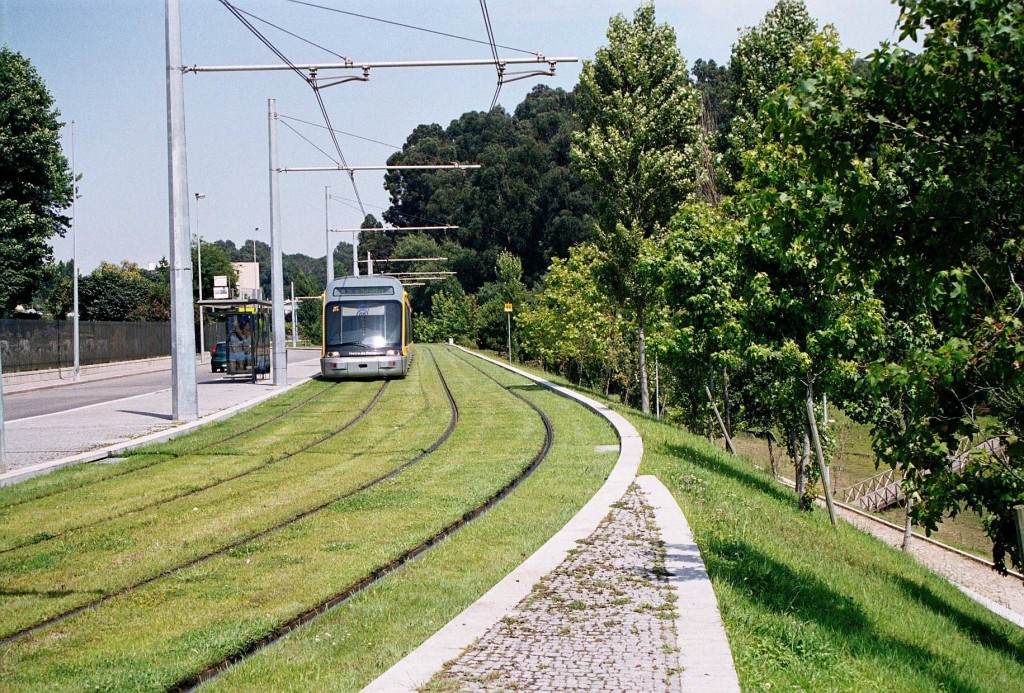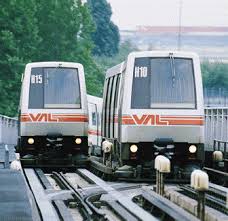In Search of the Light Rail Renaissance
A little history.
On April 22, 1978, the city of Edmonton heraldedAi?? a new era of what we now call light rail transit, with the opening of its first 6.9 km, LRT line.
Using the now venerable Siemens U-2 vehicle, which was designed for the Frankfurt U-Bahn metro system. Edmonton’s new LRT line set the standard for modern LRT in North America.
In Europe, it was a different story, where tramways were being abandoned in the 1960’s and 70’s in favour of subway construction and/or gadgetbahnen, like the VAL mini-metro. Huge construction costs combined with large debt servicing and disappointing ridership, made subways extremely expensive to not only build, but to operate. As the subway costs increased the level of service on non subway services diminished.
The burdensome cost of heavy-rail metros, either in subways or on viaducts, encouraged the mini-metro, like VAL, which were somewhat successful in operation, yet their own high costs and lack of operational flexibility prevented wide spread expansion.
In France, where auto congestion was reaching new heights, the central government was planning major expenditures in public transit, but focused on the VAL mini-metro, then owned and produced by MATRA, France’s chief arms manufacturer.
The first major VAL installation, opened in 1983 in Lille France and today the 45 km. VAL network comprises of two lines, providing quality public transport for almost 100 million customers annually, but there was a problem, the VAL was both expensive to build and expensive to operate.
So expensive was VAL, that it was far cheaper to completely refurbish, with new tracks and cars, a worn out metre gauge interurban line, locally known as the Mongy.
Many French cities contemplating building with the VAL light metro took note.
The French government offered to underwrite the first VAL Line (it was thought that a lack of confidence in VAL, meant a lack of confidence with MATRA, the French arms manufacturer), with the operating authority paying for extensions. Though the offer tempted some cities to build with VAL, prudent city fathers foresaw the ruinous costs to extend the initial small VAL Line and opted to build with modern LRT or the “tram” as light rail is called in Europe.
In France, as of 2013, there are 25 operational tram systems, with three under construction and many more in various stages of planning. Only six VAL mini-metros have been built, including Lille, with two being airport people movers.
The same is true of VAL’s competition in North America, with the Canadian ICTS/ALRT/ART proprietary transit system, locally called SkyTrain, with only two being built in Canada (two SkyTrain’s have been built in the USA, with one being an airport people mover and the other a single track loop demonstration line) despite the federal government trying to force SkyTrain on various operators.
Ai??Low-floor cars and the reserved rights-of-way
In Germany, until the early 80’s, it was thought the city tram would be all but extinct by the year 2000, replaced mainly byAi?? S-Bahn’s and U-Bahns. As U-bahn or subway costs soared and ridership on the new subways were at very disappointing levels and S-Bahns mainly used larger articulated tram stock operating on existing railways, planners in Germany and elsewhere once again looked at the tram.
To make trams faster and carry more people, trams had to be designed to be cheaper and faster.
To make trams faster, tram designers reinvented the low-floor tram, permitting shorter dwell times and reinvented the 1930’s concept of the ‘reserved rights-of way’ (R-R-o-W) or a R-o-W reserved for the exclusive use of the tram. The combination of the two, plus priority signalling at intersections, gave the tram and operating capability that was on par or better than the proprietary mini-metros on the market, at a much cheaper price.
The unintended consequence of the low-floor tram was that it was ideal for the mobility impaired transit customer, giving him or her complete access to the tram system without cumbersome and expensive wheelchair lifts, hoists and ramps. So popular was the low-floor tram that a new category of mobility impairment was created and that was babies in prams and their caregivers. Cities investing in new low-floor trams saw a dramatic rise with mothers and fathers with infants and small children as the low-floor car made travel by public transit that much easier.
It was found that just 40% of a tam line operating on R-R-o-W’s could permit a tram to compete against mini-metros and the more RRoW on a tram line the faster the commercial speed and the ability to compete against all but the largest metro lines.
Today in Europe, the modern tram line operates mostly longer modular cars on mostly R-R-o-W’s many lawned throughout making the tram line a linear park, a vital part of the cityscape.
This is what we call the Light Rail Renaissance.
Ai??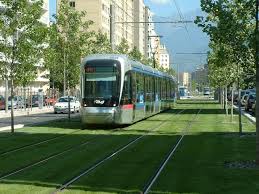 Classic lawned R-o-W in Grenoble, France
Classic lawned R-o-W in Grenoble, France
North America
LRT construction in North America was and still is strong, but the evolution of LRT has not progressed very far, with light rail seen as a interurban, being completely different than a streetcar, with LRT and streetcar lines being segregated. Propelled by both political intrigue and planning hubris, the positive effects of modern LRT has been retarded. There are exceptions such as Calgary, which carries more customers than any other new build LRT line and Portland, where planners have the foresight (and political backing) to plan for 20 or 30 years from now, giving Portland the LRT network it needs to attract the motorist from the car. Portland was also the first North American city to order low-floor cars.
On the same theme, Toronto will be operating the first modular low-floor cars in North America, soon to be followed by Ottawa, yet the economics of modular cars are poorly understood on the North American continent. In fact, several transit professionals in the USA still cling to the venerable PCC car and remain blind deaf and dumb, with events in Europe. Equally misunderstood is the concept of the R-R-0-W, one of the hallmarks of the light rail Renaissance, where hugely expensive grade separations, either on viaduct or in a subway, hold sway.
The current hubris with the Light Rail Renaissance has made it possible for proprietary mini-metros to compete against LRT, as LRT projects with major grade separations, either in viaduct and or subway has made the cost of light rail almost as dear as subway construction. There are many reasons for this, including the concept that new transit construction not interfere with road capacity; planners who receive in payment a percentage of the cost of a new transit system, thus giving no incentive to build cheaply; politicians who use new transit systems as an election ploy and spare no cost to make the transit look good to encourage voters; and a North American arrogance that they are better in providing good public transit and ignore or pooh-pooh European transit developments.
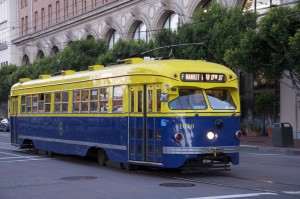 Many US planners pine for the venerable PCC
Many US planners pine for the venerable PCC
Canada Again
It is in Canada, where modern LRT was first operated, the Light Rail Renaissance is beginning to take hold.
Toronto is replacing its aging tram fleet with European style low-floor modular cars, greatly increasing capacity and reducing operating costs and in Ottawa, classic low-floor modular cars, built by Alstom are the feature of the city’s new light rail line.
With the low-floor modular cars, also is the concept of the reserved rights-of-way, though many city planners have yet to understand the difference (or lack of difference) of a R-R-o-W and full grade separation, or that a R-R-o-W is much cheaper, yet gives the same effect of a subway or viaduct operation.
The lawned or grassed R-o-W is also a new concept that is greatly misunderstood and in Toronto, the fire department nixed the idea of lawned R-o-W’s for fear their fire appliances would get bogged down on them, despite the fact there are measures in place to prevent this.
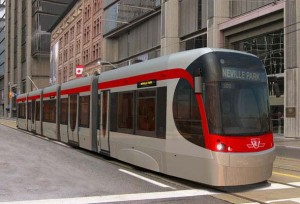 The modern low-floor modular car in Toronto.
The modern low-floor modular car in Toronto.
Ai??Slowly, ever slowly the Light Rail Renaissance is reaching our shores and more and more planners are embracing what modern LRT can achieve. There are nay-sayers; there are Luddites, who don’t want to change, but as a new generation of public transit planners are taking over, the old ways and the old concepts are slowly becoming a thing of the past and hopefully soon, all transit planners in North America will embrace the Light Rail Renaissance, just like another Renaissance four to five hundred years before.
The future is modern light rail and the future is very friendly!
